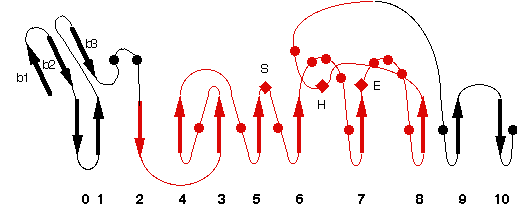4TPK
Name : Human butyrylcholinesterase in complex with N-((1-(2,3-dihydro-1H-inden-2-yl)piperidin-3-yl)methyl)-N-(2-methoxyethyl)-2-naphthamide
Revelation date : 22-Oct-2014
Family : BCHE
Gene_locus : human-BCHE
PDB file : ESTHER: header of PDB entry RCSB: Full entry
Comment
Brus, B., Kosak U, Stojan, J., Turk, S., Pislar, A., Coquelle, N., Colletier, J.P., Kos, J., Gobec, S.
Ligand :
References (1)
| Title : Discovery, biological evaluation, and crystal structure of a novel nanomolar selective butyrylcholinesterase inhibitor - Brus_2014_J.Med.Chem_57_8167 |
| Author(s) : Brus B , Kosak U , Turk S , Pislar A , Coquelle N , Kos J , Stojan J , Colletier JP , Gobec S |
| Ref : Journal of Medicinal Chemistry , 57 :8167 , 2014 |
| Abstract : Brus_2014_J.Med.Chem_57_8167 |
| ESTHER : Brus_2014_J.Med.Chem_57_8167 |
| PubMedSearch : Brus_2014_J.Med.Chem_57_8167 |
| PubMedID: 25226236 |
| Gene_locus related to this paper: human-BCHE |
Representative scheme of Prolylcarboxypeptidase structure and an image from PDBsum server

